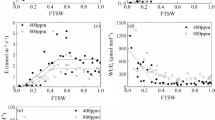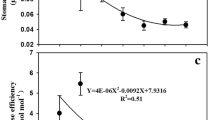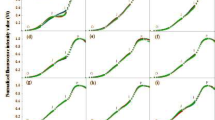Abstract
Sufficient nitrogen and shade may benefit photosynthetic down-regulation at elevated CO2 concentrations. Two levels of atmospheric CO2 400 and 760 μmol mol−1 were simulated using controlled environment open-top chambers, wheat (Triticum aestivum L) was grown at two N application rates (0 and 200 mg N kg−1 soil), and two photosynthetic photon fluxes (PPF, 100 and 60 % of solar irradiance). The increasing leaf N concentration, shade and N application extended the wheat developmental period and increased flag leaf fresh mass, water content, plant height and spike length by 11 d, 125, 126, 29 and 43 %, respectively. However, with sufficient N and elevated CO2, shade decreased dry mass, kilo-grain weight, instantaneous water use efficiency, grain water use efficiency and photosynthetic N use efficiency was increased by 30, 12, 2, 36 and 44 %, as compared with the unshaded treatment. Higher N application and shade increased N and chlorophyll concentration in flag leaves by 135 and 35 %, resulting in extended growth stage and increased plant and leaf water content, caused significant increments of plant height, grain number per spike and grain weight per spike under elevated CO2 as compared to N-deprived (0 mg N kg−1 soil) and unshaded treatment. Shade significantly increased leaf and plant water content, but did not affect wheat water and nitrogen use efficiency, which indicated that the decline of water content in flag leaves was a response of wheat to elevated CO2. The increment of leaf water status may extend the growth period to relieve photosynthesis acclimation at elevated CO2.

Similar content being viewed by others
Abbreviations
- Elevated CO2 :
-
Elevated atmospheric CO2 concentration
- Ambient CO2 :
-
Ambient atmospheric CO2 concentration
- N:
-
Nitrogen
- N-deprived:
-
0 mg N kg−1 soil
- N-sufficient:
-
200 mg N kg−1 soil
- P n :
-
Net photosynthesis rate
- C i :
-
Intercellular CO2 concentration
- Ca :
-
Atmospheric CO2 concentration
- Ci/Ca :
-
Ratio of intercellular to atmospheric CO2 concentration
- G s :
-
Stomatal conductance
- T r :
-
Transpiration rate
- LWC:
-
Leaf water content
- DM:
-
Dry mass
- FM:
-
Fresh mass
- WUE i :
-
Instantaneous water use efficiency
- WUE g :
-
Grain water use efficiency
- NUE p :
-
Photosynthetic nitrogen use efficiency
References
Ainsworth EA, Long SP (2005) What have we learned from 15 years of free-air CO2 enrichment (FACE)? a meta-analytic review of the responses of photosynthesis, canopy properties and plant production to rising CO2. New Phytol 165:351–372
Kirschbaum MUF (2011) Does enhanced photosynthesis enhance growth? lessons learned from CO2 enrichment studies. Plant Physiol 1:117–124
Rogers A, Ellsworth DS (2002) Photosynthetic acclimation of Pinus taeda (loblolly pine) to long-term growth in elevated pCO2 (FACE). Plant, Cell Environ 25:851–858
Rogers A, Gibon Y, Stitt M, Morgan PB et al (2006) Increased C availability at elevated carbon dioxide concentration improves N assimilation in a legume. Plant, Cell Environ 29:1651–1658
Luo YQ, Su B, Currie WS et al (2004) Progressive nitrogen limitation of ecosystem responses to rising atmospheric carbon dioxide. Bioscience 54:731–739
Pettersson R, McDonald AJS (1994) Effects of nitrogen supply on the acclimation of photosynthesis to elevated CO2. Photosynth Res 39(3):389–400
Reich PB, Hobbie SE, Lee T, Ellsworth DS, West JB, Tilman D, Knops JM, Naeem S, Trost J (2006) Nitrogen limitation constrains sustainability of ecosystem response to CO2. Nature 440:708–922
Ainsworth E, Rogers A (2007) The response of photosynthesis and stomatal conductance to rising [CO2]: mechanisms and environmental interactions. Plant, Cell Environ 30:258–270
Evans JR (1983) Nitrogen and photosynthesis in the flag leaf of wheat (Triticum aestivum L.). Plant Physiol 72:297–302
Perchorowica JT, Raynesm DA, Jensen RG (1981) Light limitation of photosynthesis and activation of ribulose bisphosphate carboxylase in wheat seedlings. Proc Natl Acad Sci 78:2985–2989
Shangguan ZP, Shao MA, Dyckmans J (2000) Effects of nitrogen nutrition and water deficit on net photosynthetic rate and chlorophyll fluorescence in winter wheat. J Plant Physiol 156:46–51
Ellsworth DS, Reich PB, Naumburg ES, Koch GW, Kubiske ME, Smith SD (2004) Photosynthesis, carboxylation and leaf nitrogen responses of 16 species to elevated pCO2 across four free-air CO2 enrichment experiments in forest, Grassland and Desert. Glob Change Biol 10:1–18
Ines C, Terezinha FF (2004) Effect of nitrogen supply on growth and photosynthesis of sunflower plants grown in the Greenhouse. Plant Sci 166:1379–1385
Kubiske ME, Pregitzer KS (1996) Effects of elevated CO2 and Light availability on the photosynthetic light response of trees of contrasting shade tolerance. Tree Physiol 16:351–358
Zhang JZ, Zhou MY, Li XD, Yu XB, Jiang CD, Sun GF (2007) The single and interactive effects of nitrogen application rate and light condition on hosta blue umbrella growth and photosynthetic characteristics. Acta Horticult Sinica 34:1497–1502
Zhao L, Yang YJ, Lin D (2007) Effect of light intensity on photosynthetic characteristics and quality of Taraxacum mongolicum. Acta Horticult Sinica 34:1555–1558
Attipalli RR, Girish KR, Agepati SR (2010) The impact of global elevated CO2 concentration on photosynthesis and plant productivity. Curr Sci 1:46–57
Miller TD (1992) Growth stage of wheat: identification and understanding improve crop management. Potash Phosphate Inst, USA
McGill WB, Figueiredo CT (1993) Total nitrogen. In: Carter MR (ed) Soil sampling and methods of analysis. Lewis Publishers, London
Hartmut KL, Alan RW (1983) Determinations of total carotenoids and chlorophylls a and b of leaf extracts in different solvents. Biochem Soc Trans 11:591–592
Anderson LJ, Maherali H, Johnson HB, Polley HW, Jackso RB (2001) Gas exchange and photosynthetic acclimation over subambient to elevated CO2 in a C3–C4 Grassland. Glob Change Biol 7:693–707
Zhang SR, Dang QL (2006) Effects of carbon dioxide concentration and nutrition on photosynthetic functions of white birch seedlings. Tree Physiol 26:1457–1467
Lin ZF, Peng CL, Sun ZJ (2000) The effects of light intensity on the photorespiratory allocation of photosynthetic electron transports of four subtroical forest plants. Sci China 1:72–77 [In Chinese]
Hunsaker DJ, Kimball BA, Pinter PJ, Wall GW, LaMorte RL, Adamsen FJ, Leavitt SW, Thompson TL, Matthias AD, Brook TJ (2000) CO2 enrichment and soil nitrogen effects on wheat evapotranspiration and water use efficiency. Agric For Meteorol 104:85–105
Zhu XG, Long SP, Ort DR (2010) Improving photosynthetic efficiency for greater yield. Annu Rev Plant Biol 61:235–261
Gulmon SL, Chu CC (1981) The Effects of light and nitrogen on photosynthesis, leaf characteristics, and dry matter allocation in the chaparral shrub, Diplacus aurantiacus. Oecologia (Berl) 49:207–212
Atkin O, Evans JR, Ball MC, Lambers H, Pons TL (2000) Leaf respiration of snow gum in the light and dark. interaction between temperature and irradiance. Plant Physiol 122:915–923
Evans JR, Poorter H (2001) Photosynthetic acclimation of plants to growth irradiance: the relative importance of specific leaf area and nitrogen partitioning in maximizing carbon gain. Plant, Cell Environ 24:755–767
Meir P, Kruijt B, Broadmeadow M, Barbosa E, Kull O, Carswell F, Nobre A, Jarvis PG (2002) Acclimation of photosynthetic capacity to irradiance in tree canopies in relation to leaf nitrogen concentration and leaf mass per unit area. Plant, Cell Environ 25:343–357
Cai XA, Sun GC, Zhao P, Liu XJ (2008) High-nitrogen and low-irradiance can restrict energy utilization in photosynthesis of successional tree species in low subtropical forest. Sci China (C-Life) 51:592–603
Tissue DT, Lewis JD, Wullschleger S, Amthor JS, Griffin KL, Anderson OR (2002) Leaf respiration at different canopy positions in sweetgum (Liquidambar styraciflua) grown in ambient and elevated concentrations of carbon dioxide in the field. Tree Physiol 22:1157–1166
Stitt M, Krapp A (1999) The interaction between elevated carbon dioxide and nitrogen nutrition: the physiological and molecular background. Plant, Cell Environ 22:583–621
Yusuke O, Tadaki H, Kouki H (2007) Effect of elevated CO2 levels on leaf starch, nitrogen and photosynthesis of plants growing at three natural CO2 springs in Japan. Ecol Res 22:475–484
Takeuchi Y, Kubiske ME, Isebrands JG, Pregitzer KS, Hendrey G, Karnosky DF (2001) Photosynthesis, light and nitrogen relationships in a young deciduous forest canopy under open-air CO2 enrichment. Plant, Cell Environ 24:1257–1268
Ainsworth EA, Ort DR (2010) How do we improve crop production in a warming world? Plant Physiol 2:526–530
Christine AR (2011) Increasing photosynthetic carbon assimilation in C3 plants to improve crop yield: current and future strategies. Plant Physiol 1:36–42
Acknowledgments
This work was supported by grants from the National Natural Science Foundation of China (Nos. 31160090, 30800668).
Author information
Authors and Affiliations
Corresponding author
Rights and permissions
About this article
Cite this article
Zhang, Xc., Yu, Xf., Hou, Hz. et al. Effect of Nitrogen and Shade on Photosynthetic Gas Exchange and Productivity of Wheat Under Elevated Atmospheric CO2 Concentration. Proc. Natl. Acad. Sci., India, Sect. B Biol. Sci. 87, 965–974 (2017). https://doi.org/10.1007/s40011-015-0680-0
Received:
Revised:
Accepted:
Published:
Issue Date:
DOI: https://doi.org/10.1007/s40011-015-0680-0




